The seller of this 1948 Packard Eight Club Sedan doesn’t have a lot to say about it but barn finder Brian C. suggests that it may be a “decent project car”, so let’s dive in and see if that’s the case. This Packard is located in Independence, Missouri and is available, here on Facebook Marketplace for $8,000.
While the model level is not disclosed, the lack of trim and the roofline of this two-door Packard would leave one to believe that it is a base level Eight Club Sedan. The overall design is reflective of the era and not totally dissimilar to this 1949 Nash reviewed last week. Packard was considered a high-brow automobile and the top drawer Packard Super Eight was just that. But in the postwar years markets started to change and it became necessary to cover additional, lower-rung bases. The 1948 sales brochure suggests, “Packard value is here in full measure…”
So, solid it looks, there is some minor rust that is evident in the lower passenger-side fender but that’s about it. We’re minus wheel covers (there’s at least one inside) but not trim and the chrome plating is still fair – even the beige finish still possesses a modicum of a shine. The bodywork appears to be pretty heavy-gauge – reminiscent of the time, I suppose, and there is no evidence of crash damage. The swept-back aero design is a matter of preference.
The 130 HP, 288 CI, straight-eight, flathead engine is a non-runner but in one of the few comments carried in the listing, we are told, “Doesn’t run but no (sic) locked up either“. OK, well that’s a start towards a decent project and from what can be seen, the engine looks complete. As is the standard setup, a three-speed manual transmission handles gear changes.
The interior, specifically the rear seat, gives one a look at how a Packard standard Eight’s upholstery appeared. I was thrown by it at first, but the sales brochure states, “…tailored in a smart new checked broadcloth“. Well, it may be new, and it’s certainly checked, though it looks more like plaid. It’s a safe bet that the front seat has been reupholstered with something that would look more fitting in a taxicab. The entire interior environment, however, presents pretty well, the floors appear to be sound while the instrument panel’s gauges are clear and bright – even the headliner is not earthbound.
So, a verdict? Sure, this Packard does look like a decent project car and a solid base for a restoration. Considering its completeness, a non-modified stock vibe would seem to be the one to pursue – assuming that old flathead eight can be jolted back to life. Now, if some checked broadcloth upholstery for the front seat could just be located, this Packard will be back in tall cotton, right?







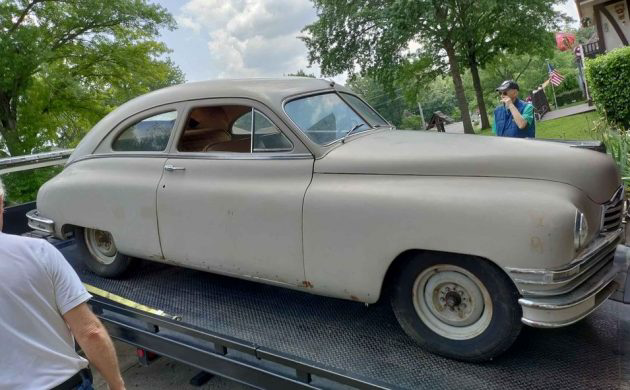
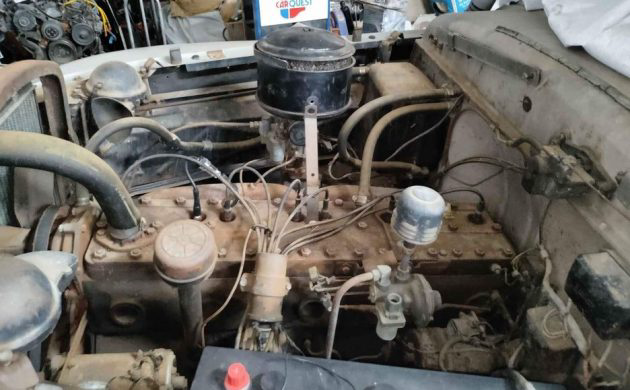
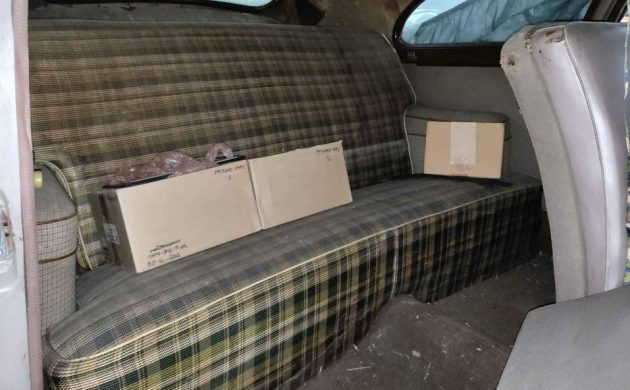
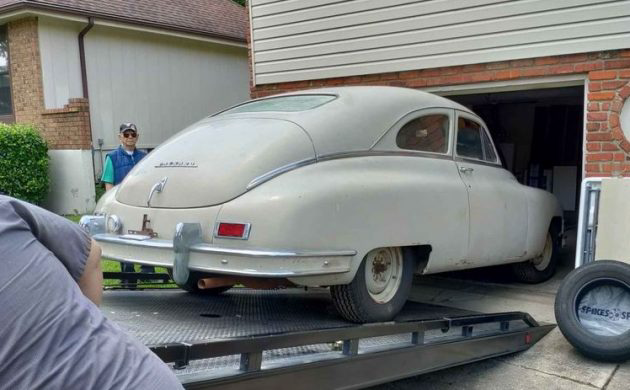


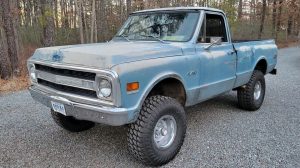
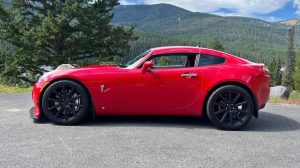


I never did like this series of Packards. especilly base models like this one; it has all the visual appeal of an enema bag.They make the `49-`51 Nash look downright aerodynamic.
Don’t see cars like this in the UK often but the first thought I had would b make a leadsled type cruiser, (wouldn’t chop the roof tho) drop it on air ride & cruise “low & slow”
This would make such a nice street rod. Modern suspension with big block power and go eat up some highway miles!
I’ve owned many, many Packards of this era. This is a 22nd series Standard 8 club sedan. The easy way to tell it’s a Standard 8 and not the Deluxe 8 is the lack of a center rear seat armrest. In addition, the metal panel containing the instruments, as well as the radio grill, are painted brown, while the Deluxe 8 and more expensive Packards had these pieces chromed. The first 4 digits of the VIN should be 2295
The back seat material is actually a woven early plastic seat cover to protect the original upholstery. The side armrests show the original seat material. These seat covers are listed in the Packard dealer’s optional accessories book, and were dealer installed.
In the engine compartment can be seen a Packard option called the Electro-Matic Clutch [EMC]. It allows the driver to let the EMC handle all clutch operation. Ordering the EMC option requires the car also be equipped with the Borg-Warner R-9 overdrive as well.
The EMC is not working. There should be a vacuum line running from the opening in the top of the EMC control unit, across the engine, to a fitting in the intake manifold. When this pipe was removed, if a plug was not installed in the manifold hole, the car can’t create a vacuum in the manifold. No vacuum = no carburetor action.
This is a fairly rare 2-door Packard. Probably 80% of production were various price levels of 4-door sedans. For many years these lower-priced Packards were parted out to restore the more expensive Packards. I just checked a recent Packard Club [PAC] roster, and there were only FOUR of the 2295 cars listed. It has few options, including the deluxe front bumper uprights, radio with rooftop antenna, and full heating and fresh air system.
Based on the overall decent original condition, this is a Packard that is worth getting cleaned up and detailed, and made safe to drive and enjoy. Collected as a basically original car. Once the EMC is repaired and adjusted correctly, if a driver can shift the gear lever, and not worry about the clutch pedal, it’s quite easy to drive.
Bill I’m in awe – not as much the car, but rather your depth of knowlege. Great comment!
Yeah, that was such a comprehensive lecture on Packards and it’s thanks to knowledgeable guys like you Bill and many others that BF is such a fun site! 👍
Now, since it appears you know so much about Packards – should you have any idea how their woodgrained dashes were crafted ‘cuz I take it they are not covered in some DiNoc material but painted by hand? Were any kind of templates utilized to create a uniform look or was it all up to each individual painter?
Just as with the ’66 Olds from yesterday it strikes me how much effort the auto industry in the gone-by era would put into making even their entry level offerings attractive. Today it appears any auto maker just can’t design or manufacture cheaply enough and it shows
I have always loved the look of these postwar Packards, maybe it’s just the enormity of them. Usually, I like cars returned to stock, but this one might change my mind. I don’t like lowered vehicles, but once again this one would look nice a little lower. I would be tempted to chop the roof, but I like the rear styling, and I am afraid that would ruin the look. Paint it a rich dark color like a deep maroon. Dual exhaust, dark tint and leather interior along with beefier tires and wheels and voila. It would be cool to hear this elephant roar.
Agreed. I love it but there is something a bit off about the roofline. It’s just a touch too high. I would not chop it but just have someone like Kindig Designs (he does great work, look at the Pantera he is doing right now) “modify” the roofline just a tad and then drop the body on a new modern chassis with a decent powerplant and run it as a real sleeper. Keep it as original as possible inside and out so you only know what you are in when pappy steps on the gas
Pfft, couldn’t sport the $16 bucks for the Cormorant hood ornament, but got the aftermarket grill guards. Yep, that’s what my grandfather paid, according to a sales slip we found, for his new ’48 Custom 8. It was one of the 3 things he kept when he totaled it in 1961. The hood ornament, an outside mirror, and the radio. That hood ornament adorned our Packard for 30 years, and now sits on the mantle of my brothers fireplace. This certainly is better than the convertible. Different market, but 2 doors were extremely rare, and probably the only reason this was kept over the years. Can’t follow Bill, and add anything, except personal experiences. While it may look plain, someone got a lot of options on this car, except the hood ornament, but all that trim, was extra, and someone painted the chrome gauge surround, that red clutch pad is rare, although, I bet this Kanter in NJ has just about everything, rubber and mechanical. Luckily, not many body parts are needed. Those are in short supply.
I’m a big promoter of the straight 8, but since it’s already in poor non-running condition, just update the thing mechanically,, and be done with it. I suggest a 2 barrel, SBC, TH400, everything else, steering, brakes, etc. are more than adequate. Great find, for sure.
Seeing that photo of this Packard on the hauler, I immediately thought it looks a lot like an old Saab from the ’50s, supersized.
Great car. So complete.
A straight 8 , oh boy, room for a 425 Buick with supercharger, TKO trans , tubbed rear end and everything o the body stock. Yes I know —–old school but this upside down bath tub would have the look!!!!!!!
Guys,
Thanks for the compliments, if there is one type of car I know well, it’s the 22nd and 23rd series Packards. I’ve owned around 50 of them, from the rare 1948 6 cylinder Taxicab [my first car], to a 1948 Custom Super 8 limousine, body by Henney, and from parts cars to an almost mint 1950 Custom Super 8 sedan with only 1,100 miles since new! [Even the Firestone “Spider Web design” wide whitewall tires were still on the car and holding air!]
Local_sheriff: The woodgrained steel panels on Packards [and most vehicles at that time] were printed onto the metal [after the panel is stamped into the 3-D shape] using a very soft and flexible roller. The lighter color was sprayed onto the metal first. Once that sprayed coat is dry, the darker grain color is first applied to an engraved flat printing plate, basically a letterpress style inked plate. But instead of the plate being pressed against a flat piece of paper to produce the grain image, a very large rubber roller was rolled across the flat engraved plate, picking up a negative image of the grain. The rubber roller was then carefully rolled across the metal panel where the grain was transferred to the metal panel. The roller was so soft, it could take the curved forms of the panel, thereby fully imprinting the panel, even in the recessed sections.
The only person still doing this work is Joe Goss, he owns Woodgraining by Estes. Prior to my retirement from the restoration business 20+ years ago, I used their service and the work was incredible. Back then it was run by Bernie Estes. You can see examples of his work and how it’s done here: https://theshopmag.com/features/shop-makes-business-vintage-manufacturing-tactic/
There are other people offering hand painted panels, but all I have seen have surfaces that show the hand painting process. Only the Estes type has the perfectly smooth surfaces like the cars had when new.
There is another new process where the grained ink pattern is floated on top of water, and the part to be coated is slowly pulled up and out of the water, so the pattern imprints to the surface of the part [using surface tension]. I’ve seen examples of modern car parts done in this manner, but to date, only for camo and carbon fiber designs. I suspect as they perfect the process, someone will start offering it for various wood grains.
Vance: I’ve seen 2 examples of the 1948-50 Packard 2-door body where an attempt to chop the top failed. Both cars were in junkyards, probably because of the failed chop. One only had the windshield and the 2 doors chopped, making the area above the back seat as the highest point. It looked like someone had attached a tire inflating valve to the body and inflated it. The other car was never finished, they tried to chop it all the way back to the lower end of the trunk lid, and the lines looked horrible.
The problem on the 2-door Packards arises because the curvature of the top is one compound curve from the top of the windshield all the way back to a few inches above the rear bumper. Once the curve joins the beltline curve just past the rear window, changing the curve to match the [now lowered] upper top area, means you also need to make changes to the beltline and rear fenders. It looked like a beetle* that had been stepped on at the rear. *Not VW.
I’ve never in 60+ years seen a successful chop of this body style. The 4-door sedan is much easier to do because it has a line across the body just below the rear window. A 5″ [approximate] chop allows the rear window to be laid down, to line up to the lower edge of that line, giving a single sloping line like seen on the 2 door cars.
That said, if I was going to try to chop a 22nd series 2-door Packard, I would probably graft on the trunk lid and the panel between the trunk lid and rear window from the sedan, so I could line up the chopped upper section, and have a singular line down to the rear bumper.
Howard A: I’ve always found it interesting to see the large number of sales invoices for Packard Custom Super 8 vehicles, where the Cormorant hood ornament was treated as an accessory, when in fact ALL the Custom Super 8 cars came with the Cormorant hood ornament as standard equipment. I owned a 1948 Custom Super 8 sedan in which not just the Cormorant, but the red enamel hubcap centers, wheel trim rings, blue color interior upholstery, and turn signals, were all listed in the dealer’s invoice as additional cost options, when in fact they were ALL standard equipment on the Custom Super 8 cars.
Many dealers of ALL makes of cars, routinely listed standard equipment as extra cost accessories. This is why the Federal Government stepped in [1964?], requiring manufacturers to glue the retail price sticker with all the specific optional accessories listed, with prices, on the car’s right side window, from the factory. They also made it illegal to sell the vehicle without the MSRV invoice attached to the window.
Howard, the dash assembly seen on this car shows how plain the dash was on the bottom level Packard for 1948. For the Standard 8 the only chrome trim on the 6 cylinder cars [only available as an export vehicle or taxicab] or the Standard 8 dashboards, were the line of push buttons below the center radio grill, and the glove box handle. The parts book does not show a separate part number for the Standard 8 radio, so that means if this car was equipped from the factory with a radio, it’s the one shown here with a fully chromed face.
I’ve owned and seen several 22nd series Standard 8 vehicles that had very late VIN plates, equipped with the fully chromed dash assemblies as used in the Deluxe 8 cars, so I suspect either the cars could be ordered with the chrome dash at extra cost, or the factory simply stopped offering the base brown painted dash. These late production cars also didn’t have the center parts of the bumpers painted matching body color, as seen on this car. I’ve always thought this was because the paint peeled off the smooth chrome surface after only a few years.
As for Kanter Auto Parts, Yes, they do Know Packards, and even have a specific Packard section. The 2 founders, Fred and Dan Kanter were able to save hundreds of Packard dealer parts inventories from all over the world. Fred has had some recent medical issues, and can use some prayers and words of encouragement, if only so he can finish his one-of-a-kind 1952 Packard Patrician limousine.
You mentioned the red clutch pedal. That signifies the car is equipped with the EMC clutch. Beautifully reproduced examples are available from Steele Rubber Co, as are ALL the rubber pieces for the 22nd and 23rd series cars, all body styles.
Woah Bill, thanks for your elaborate replies and I’m pretty sure I’m not talking for myself only here. The provided link was such great read on a process I was completely unaware of.
As for the EMC clutch system it seems – at least to me – as a clever analog way to achieve clutchless driving while still avoiding slippage as associated with autos + the clutch is still there to assist for slippery surface launches. I take it that if the EMC system is inoperable it is still possible to shift transmission as a regularly clutched manual?
Whoa( sp) Bill, indeed! Obviously, Bills knowledge of these is above most. A treasure trove of information, that will probably be obsolete once he’s gone. While I question some of his facts, not in a nasty way, just there were so many combinations Packard offered, even with his knowledge, he couldn’t possibly know everything. The Cormorant WAS extra on my grandfathers Custom 8, and of all the Packards like this I had, saw, or took parts from, they all had chrome gauge trim, maybe they had radios, like Bill sez. If I remember, the radio, an old tube affair, was the most expensive option, I think over $100 bucks, ( like $2 GRAND today! )why my grandfather removed it . Just knit picky stuff, like I say, they had so many options, I don’t recall ever seeing 2 exactly alike. I’m sure the dealers, like most, mixed and matched cars they had to make a sale.
Far as shifting, there was a switch that disabled the vacuum setup, and then could be shifted normally. One of my parts cars had an O/D, ours was an automatic, so I never needed it. Wonder whatever happened to that? Probably the old man threw it away( GASP), a common fate of a lot of that kind of stuff. My grandfathers car had that EMC, and while a complicated setup, my dad said it worked rather well. I don’t recall if his had O/D, I don’t think so, but the old man said gramps had a heavy foot, and that Packard “rolled like thunder”.
Yes, the EMC can be turned off using the dash button marked “Clutch”. The 23rd series buttons were unmarked, as there was now a line of small back-lit signs above the buttons.
The change was done because the letters on the buttons were difficult to see, especially at night. For the customers who complained, Packard introduced a lamp that could be clipped onto the bottom 2 rows of the radio speaker grill above the buttons [the power wires for the lamp being inserted thru the left lower corner of the speaker grill by punching thru the grill cloth]. This provided a satisfactory method to light up the buttons.
Howard A,
I’ve seen the Packard Factory lists of optional equipment, as provided to the dealerships. In the hood ornament section, the Cormorant is listed, and next to it is “Standard on 2206, 2213, 2226, 2233 chassis cars”. Chassis 2206 is the Custom Super 8 sedan.
In treating the Cormorant as optional, it allowed the dealership to charge an additional $16 for the car. Using the CPI published rates for inflation: $16 in 1948 is worth $184.53 today. That was a lot of money, and if my memory is good, the Cormorant was available thru the parts department for around $6 [about $70 today], and could be added to all the models. That $16 was 100% profit for the dealership.
In 1968 my dad and I bought a 1950 Packard Standard 8 sedan with only 1,800 miles from new. It was equipped with a large selection of options from the factory order, including the Cormorant and the red cloisonné centers on the hubcaps. The car came to us with all the original paperwork including the invoice. I still have a copy of that invoice where it shows the options on the car. The Cormorant was about $8.
Back in the mid to late 1970s I bought out the remaining Packard dealer parts stocks from about 20 dealerships in New Jersey, Maryland, and eastern PA. In every instance I didn’t find a single Cormorant in stock, while I found numerous base model hood ornaments [as on this featured car] and the 2 types of “wheel type” ornaments. Most of these were not in the box and showed evidence of having been removed from a fairly new car, suggesting that the Cormorant had been added by the dealer, either before or after the car’s sale. [The removed parts being added to the dealer inventory!]
So Howard, the Cormorant on your family’s car was indeed standard equipment from the Packard factory, but the dealership decided to charge extra for it. In today’s world, dealerships can’t hide extra profits in that manner, thanks to the factory window sticker. Today they simply claim “Additional dealer markup” and expect the public to pay it if they want the vehicle!
There is a show called “Full Custom Garage” where they chopped a Packard roof and it looked pretty good IIRC. It’s been a while since I’ve seen that episode, but I do remember it was quite a job getting everything to look right. I think he also laid the windshield back more.
That show is now part of the Motortrend network and can be seen online. If I knew of a direct link, would post it here. I’d be interested in your take on how they did it.
I do not know which yr/model Packard they used but from memory it was similar to this one.
I really like this car in the BF ad. They are unusual today and it would be great to have it to cruise around in. I think if I had it, would be a quandry on whether to modernize the drivetrain, add AC, better suspension/brakes, or to leave this time capsule alone and restore it to the point of being safe/reliable to drive, then just enjoy it. They’re only original once as they say.
Miminite,
I’ve watched every episode of that show, and I am amazed at what Ian is able to do, especially when one considers the lack of metal shaping equipment in his shop. I wish the show was still in production.
I loved what he did to the 1950 Packard Deluxe 8 sedan, it’s one of the few I’ve seen that looked “right”.
Bill – I’ve read your comments, and I thank you for your wealth of knowledge on these cars. The first family car I remember was my Dad’s ’47 Packard. Still have a couple B&W photos somewhere. It was a “fancier” model 4 door. Medium dark brown and tan. He never bought new in those days, “let someone else break it in” was his motto. Remember that it was very comfortable, and good on the highway, as we took it to visit his brothers farms in Michigan hundreds of miles away (pre-expressways). I also agree with leaving that roof alone. Have seen enough 49-50 Merc’s with chopped tops to last a lifetime. Who really wants a “gun-slit” for a back window ? Happy and healthy New Year to you and yours !
Bill – One could collect all your posts and create a very useful old car knowledge base. Your knowledge and experience are a wonderful asset for BarnFinds. The more you post, the better!
Astonishing depth and breadth of knowledge! Water-transfer (or hydrographic) printing has really taken off. There is at least one company offering it to OEMs, and at a glance their woodgrain patterns – in straight and burl – are very impressive.
https://watertransferprinting.com/product-cat/hydrographic-film/wood-grain/
Do an engine swap using a Packard V8 form ’55 or ’56. Make it a modern crusier with some HP. Not sure I would use an Ultramatic, Maybe a GM R4 or? Would not dstroy the Packard DNA.
Connor, some of the 1954 Packard straight eights had 208 Horsepower with a four barrel carb. Yes, keep it all Packard for more horsepower.
I spent many hours in the front passenger seat of one, a mother of a friend driving, she hardly ever used 2nd gear since it was such a long throw for her, and 1st and 3rd were just fine for everywhere we were going around town. She could also start it from a dead stop in 3rd, without burning a lot of clutch, which she would do as a demonstration to us early adolecsent boys of what a great car a Parkard was. I went to my 50th HS reunion, looked across the room, and said, “What is ……’s mother doing here?” Of course it was …… which I figured out as I crossed the room to say Hello. Looked just like I remembered her mother looking as she drove us kids around in the Packard.
Packards have class. If the straight 8 is in good condition keep it, they’re excellent power-plants, plus it’s still got a Packard heart. The Ultramatics are troublesome… I’d use something else… Over drive would be good. These cars are not for everyone, but Packards are sweet machines and take on the highway with style.
I am aware of the enormous torque of the straight 8 and what a great engine it is. But I am a big fan of the ’55 and ’56 Packard’s and their V8 engines. My dream is to someday own a 55/56 Caribbean or at least a 400. As an aside I remember a huckster selling spark enhancers at the local county fair. His demonstration vehicle was a 53/53 straight Packard, A Patrician? He would pull the spark plug wires of a number of cylinders and the engine would run a smooth as glass.
Delighted to see the air cleaner is still there! Should bode well for condition the intake manifold.
The change from painted dash trim to chrome was a running change early in the production of the 22nd Series Standard Eight. The Cormorant hood ornament was definitely standard equipment on the Custom Eight. I own two 1949 Custom Packard Touring Sedans. a 22nd and a 23rd Series.
I love Packards, this one appears to be in generally good condition. I would get it to run & drive, then do just that lol.
Bill, thank you for all of the information. Once I buy another one (I had one back in the 1980’s, and it was a running parts car lol) I may be asking you for advice. I hope you won’t hate me when I get through with it lol.
Stevieg and everyone,
Thank you for the kind words. While there are other people who have a wealth of Packard knowledge, I am happy to share what I know with Barn Find friends. My email is billmccoskey@aol.com, and I welcome questions and comments. If I don’t have the answer to your Packard question, I probably know someone who does know!
It’s still showing as available. I wish I could scoop it up but can’t take on another project and it would have to sit outside in the FL weather. I tell you what, after reading Bill’s and other comments, would for sure have to keep that straight 8 if it’s in decent or rebuildable shape. For sure, a SBC in that spot would be sacrilege. I’d think there are some good performance mods for this engine, and a turbo/blower would wake things up as well if extra performance is a must. I like it! Dang, I need build another garage workshop!
For those desiring to keep it mostly Packard, the engine can be updated to the Super 8 engine of 327 Cu In. Plus, the 1953/54 Senior Packards offered a 4 barrel carb. If one was to go with the 1951-54 straight 8, it will require a change of front motor mounts. If going to all that work, I would try to find a complete 51 to 54 senior motor to rebuild and install, that engine has a NINE main bearing crank, and develops a lot of torque.
I was at a Packard meet in Warren Ohio about 5 years ago, and in attendance was a 1953 [?] Packard with a turbo on the motor.
There is a guy in Michigan who has been successfully drag racing a 1948 Packard sedan. Here’s a link to a Motor Trend story on Dave Koffel’s cars:
https://www.motortrend.com/features/hrdp-1002-flintstone-flyers/
Bill, I read the article on Dave Koffel but am unclear on what he’s running in the Packard. He mentions a 283 Chevy when he was first racing it and the guidance he received from Crane. The rest of the article talks about his association with Mopar and his current day shop.
What is the current Packard setup?
Here is a very well-done 1946 Packard 2-door that was chopped, done in 1989: https://nl.pinterest.com/pin/35888128252700622/